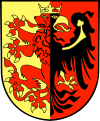Sieradz
Sieradz [ˈɕerat͡s] (![]()
Sieradz | |
|---|---|
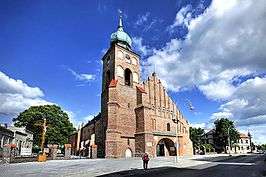 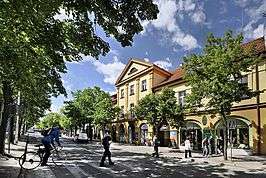 Parish church (top) and Kościuszko Street (bottom) | |
 Flag 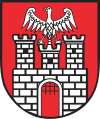 Coat of arms | |
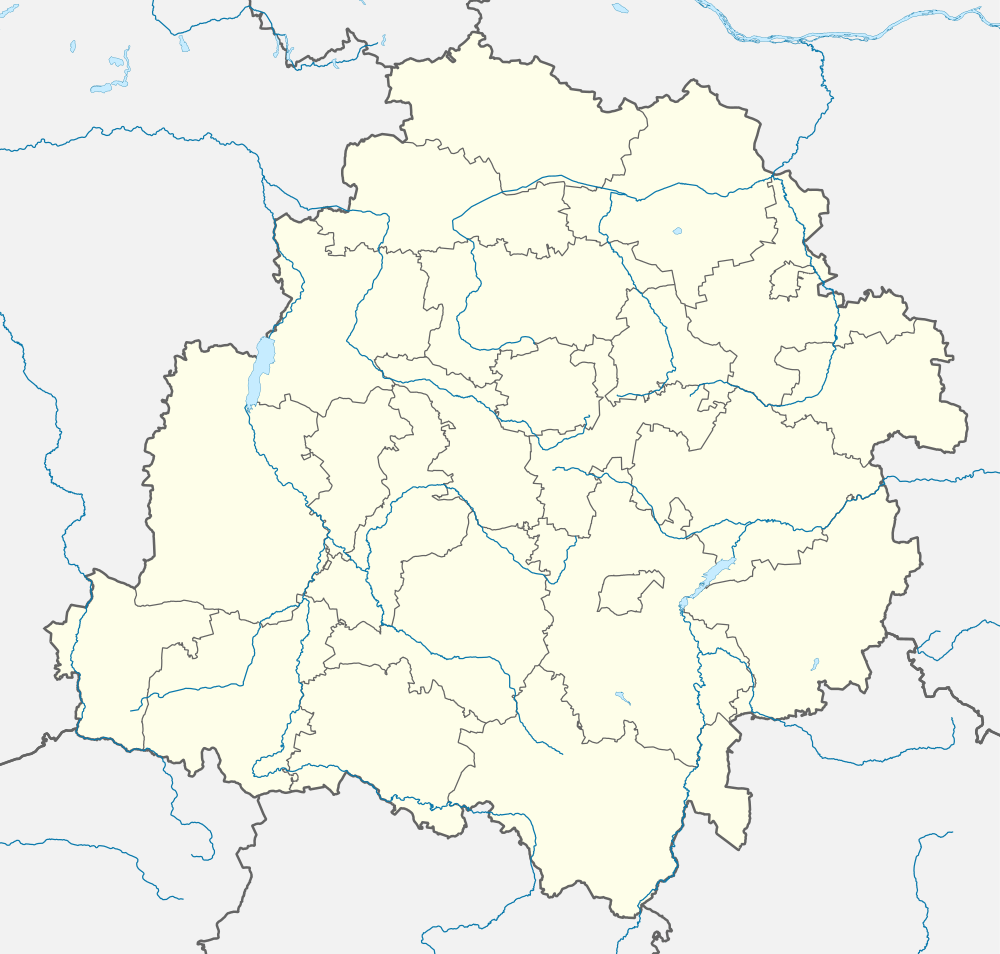 Sieradz 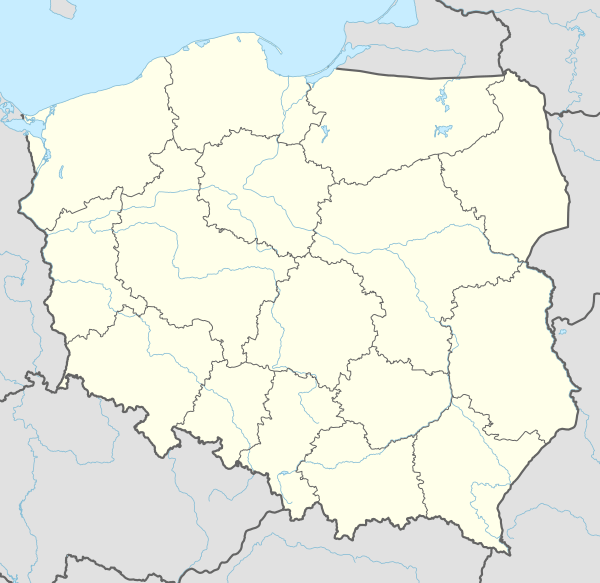 Sieradz | |
| Coordinates: 51°36′N 18°45′E | |
| Country | |
| Voivodeship | |
| County | Sieradz County |
| Gmina | Sieradz (urban gmina) |
| Established | 11th century |
| Town rights | 1247 |
| Government | |
| • Mayor | Paweł Osiewała |
| Area | |
| • Total | 51.22 km2 (19.78 sq mi) |
| Population (31.12.2016) | |
| • Total | 42,762 |
| • Density | 830/km2 (2,200/sq mi) |
| Time zone | UTC+1 (CET) |
| • Summer (DST) | UTC+2 (CEST) |
| Postal code | 98-200 |
| Area code(s) | +48 043 |
| Car plates | ESI |
| Website | www |
It is one of the oldest towns in Poland, thrice being a location for the coronation of the Polish monarchs. The town was attacked by the Tartars, Bohemians and Teutonic Knights. Polish Kings chaired six assemblies from here.
History
The oldest settlements can be traced back to almost 6th century. Centuries later, king Casimir the Great built the Castle of Sieradz.
In the mid 13th century it was conferred with Municipal rights. It had also welcomed many settlers from Scotland & Netherlands after the 13th century. During the fragmentation of Poland, it was the site of the Duchy of Sieradz.
In 1445 the election of King Casimir IV Jagiellon took place at this town. Until the 16th century the town used to be important trade centre. Merchants from Spain & Portugal were frequently visiting the town for Trade and commerce. In the 17th century due to the Swedish wars, plagues, fires and floods the town lost its trading importance and fell from its prime. In the 18th century the reconstruction of town commenced. The residents during that time were only approximately 1500.
Nineteenth and twentieth centuries
On 13 November 1806 an uprising against the Prussians took place in Sieradz. It was the capital of a district within the Kalisz Governorate of the Russian Empire until the establishment of the Polish Second Republic in 1918.[2]
With the invasion of Poland and the outbreak of the Second World War in 1939, Sieradz was attacked on September 9 and occupied by the Wehrmacht. Annexed by Nazi Germany, it was renamed Schieratz and administered as part of the county or district (kreis) of the same name within Reichsgau Wartheland.
The Nazis destroyed traces of Polish culture, destroying historical records, monuments, and buildings. Street names were changed in an effort to wipe out any connection with a Polish identity. Bombed by the Soviets, more than 100 residents were killed. After an assault lasting three days, the Red Army arrived on January 23, 1945.
Following the war, it became part of the People's Republic of Poland. Economic activities included clothing manufacture, cereal-milling, spirit distillery, potato farming and other agricultural activities. In 1957 the knitting plant "Sira" was founded.
Historical rulers
Dukes of Sieradz-Łęczyca
- 1228-1232 Henry I the Bearded (Filip I Brodaty)
- 1232-1233 Konrad of Masovia (Konrad Mazowiecki)
- 1234-1247 Konrad of Masovia (Konrad Mazowiecki)
- 1247-1260 Casimir I of Mazovia (Kazimierz I Mazowiecki)
- 1260-1275 Leszek the Black (Leszek Czarny)
- 1275-1294 divided into two duchies of Sieradz and Łęczyca (below)
- 1294-1297 Ladislaus III the Short (Władysław Łokietek)
- 1297-1305 Wenceslaus II of Bohemia (Wacław II Czeski)
after 1305 parts of the united Kingdom of Poland initially as two vassal duchies, later incorporated as Łęczyca Voivodeship and Sieradz Voivodeship.
Dukes of Sieradz
- 1233-1234 Boluslaus I of Mazovia (Bolesław I Mazowiecki)
- 1275-1288 Leszek the Black (Leszek Czarny)
- 1288-1294 Ladislaus III the Short (Władysław Łokietek )
- 1327-1339 Przemysl of Cuiavia (Przemysł Kujawski)
After 1305 part of the united Kingdom of Poland as a vassal duchy, later after 1339 incorporated by the Polish king Casimir III the Great as the Sieradz Voivodeship.
Politics
Sieradz constituency
Members of Parliament (Sejm) elected from Sieradz constituency
- Andrzej Biernat, PO
- Agnieszka Hanajczyk, PO
- Cezary Tomczyk, PO
- Artur Dunin, PO
- Wojciech Szczęsny Zarzycki, PiS
- Tadeusz Woźniak, PiS
- Marek Mauszewski, PiS
- Krystyna Grabicka, PiS
- Piotr Polak, PiS
- Stanisław Olas, PSL
- Mieczysław Łuczak, PSL
- Anita Błochowiak, LiD
- Denise Sieradzki, PiS
President of Sieradz
- Paweł Osiewała
Notable people of Sieradz
- Leszek II "the Black" (c.1240-1288) - High Duke of Poland
- Jan Gruszczyński - a medieval Primate of Poland
- Cyprian Bazylik (c.1535–c.1600) - musician, writer, printer.
- Ary Szternfeld (1905–1980) - aerospace scientist
- Antoni ”Antoine” Cierplikowski (1884–1976) - celebrity hairdresser
- Arek Hersh - Holocaust survivor and educator
- Zalman Ben-Ya'akov (1897–1959) - Israeli politician
Sport, tourism and recreation
Sieradz has a fully equipped Sports town centre, with three proper Soccer fields, running track, two sports grounds, hotel, restaurant, tennis courts, sauna, health club, games, swimming pool and well guarded river side swim area. The natural forests on the banks of river Warta makes an ideal place for mushroom pickers. The town square also makes a perfect tourism place with local shops selling various products of good quality and brands. The Churches in Sieradz carry historical significance and well restored.
Development
Sieradz dramatically developed since 2007 with new residential projects & townships. Sieradz has some attractive shopping malls, such as Galeria sieradzka, Dekada, Rondo and several open markets. Its attracts residents from nearby villages and towns as well and makes Sieradz a prime shopping destination. The Sieradz City administration successfully holds Open Hair Festival every year and the town is very much well known for this event.
See also
- Dukes of Sieradz-Łęczyca
References
- Population. Size and Structure and Vital Statistics in Poland by Territorial Division in 2016, as of December 31 (PDF). Warszawa: Główny Urząd Statystyczny. 2017. p. 116. ISSN 2451-2087.
- "Kalisz". Encyclopædia Britannica. Volume 15. p 642. Accessed via Google Books 10/6/11.
External links
| Wikimedia Commons has media related to Sieradz. |
- Official Sieradz town website
- Discussion forum of Sieradz
- . Encyclopædia Britannica (11th ed.). 1911.
